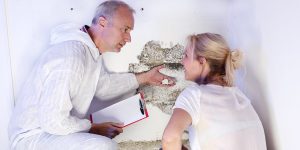
A Guide to Mold Inspection And Testing Services
Do you smell something funky in the air? It could be mold, and that’s not something to take lightly. Mold growth can have serious health implications and cause property damage. That’s why it’s crucial to have a mold inspection and testing performed as soon as possible. Mold growth is a serious issue that can cause health problems and property damage. If you suspect that mold may be present in your home or workplace, it’s imperative to take action immediately.
Opting for Mold inspection, testing, and remediation services with a professional company is necessary to ensure that mold and moisture problem is removed safely and effectively. In this guide, we’ll briefly cover everything you need to know about identifying and testing for mold, as well as finding the right professionals to handle your home inspection. We’ll also provide tips on preventing mold growth and ensuring a safe and thorough remediation process.
What is Mold And How To Identify It?

Mold is a type of fungus that grows in moist environments and reproduces through tiny spores that float through the air. It can grow on a variety of surfaces, including paper products, cardboard, ceiling tiles, wood products, dust, paints, wallpaper, insulation, drywall, carpet, fabric, and upholstery. There are many types of mold, and none of them can grow without water or moisture.
Mold can be identified by its color and texture. Mold tends to have a higher profile and can even become fuzzy, while mildew is usually flat. Mold exhibits darker colors such as deep green and black; mildew may begin as white, then turn brown or gray. Mold can also come in shades of green, red, or black and is often confused for dirt sometimes. Lastly, mold can be identified by visual inspection or mold test.
The following are some common indications that mold may be present in your house or building:
- Water Damage: Mold flourishes in places that have been exposed to water or dampness. Water damage, such as stains on ceilings or walls, could indicate the existence of mold issues.
- Strong Odor: Mold has a strong musty stench that has been described as earthy or wet. Mold growth can be detected by detecting an unusual odor in your home or structure.
- Visible Mold Development: As previously said, mold frequently shows on surfaces as a fuzzy, greenish, brown, or black growth. Examine moisture-prone locations such as bathrooms, kitchens, and basements.
- Allergy Reactions: Mold spores can induce allergic reactions in certain persons. Mold development could be the cause of unexplained respiratory issues, skin irritation, or even other allergic reactions in you or anyone in your household.
- High Humidity: Mold flourishes in high-humidity environments. Measure the humidity in your home or building with a hygrometer. If the humidity level rises beyond 60%, it may generate conditions conducive to mold growth.
If you believe that mold is growing in your house or facility, you must act promptly. Mold can cause several health issues as well as harm to your property if left untreated. To diagnose and address the mold problem, contact a professional mold inspection and cleanup service.
Mold Inspection And Remediation
Mold inspection and remediation are two vital processes that can mitigate the risks of the presence of mold and the health problems it can cause to an individual. An indoor mold inspection involves identifying the type of mold, its location, and the extent of the damage. Once the inspection is complete, remediation can begin.
Mold remediation is the process of removing mold contamination from the affected area and preventing it from returning. It is essential to hire a professional mold remediation company to ensure that the process is done correctly. The remediation process includes removing mold, cleaning up the area, and disposing of any contaminated materials. Depending on the level of mold growth and the type of mold present, the treatment technique varies for all mold investigations.
The first step in mold inspection is to determine if there is a mold problem. This can be done by looking for visible signs of mold growth, such as black or green spots on walls, ceilings, or floors. A musty odor may also indicate a mold problem. If you find mold, a professional mold inspector can come and test the air and surfaces for mold spores. The inspector will also look for sources of moisture that may be contributing to mold growth.
To prevent mold spores from spreading to other parts of the structure, the next step in mold cleanup is to isolate the affected area. The mold will subsequently be removed by the cleanup team using specialized equipment such as HEPA air scrubbers and vacuums. To prevent mold from growing back, the remediation team will also clean and sterilize the afflicted surfaces. In extreme circumstances, the crew may be required to remove contaminated materials such as drywall or carpets.
After the mold is removed, the remediation company will clean and sanitize the area to prevent a large amount of mold from returning. They may also recommend steps to prevent future mold growth, such as fixing any leaks or improving ventilation or even inserting an indoor mold growth or moisture meter for mold detection.
Making a Jurassic Difference
Request a reliable, professional inspection and indoor quality test.
How To Choose A Professional Mold Remediation Service

Choosing the right mold remediation service is an important decision that requires careful consideration. Here are some key factors to consider when selecting a mold remediation service:
- Experience and Certification: Look for a mold remediation service with experience and certification in the industry. Certification by organizations such as the Institute of Inspection, Cleaning and Restoration Certification (IICRC) and the National Organization of Remediators and Mold Inspectors (NORMI) can assure that the company has the necessary training and expertise to handle mold remediation.
- Reputation: Check the company’s reputation by reading reviews on websites such as Google, Yelp, and Angie’s List. Ask for references and contact them to learn about their experience with the company.
- Insurance: Ensure that the mold remediation service has liability insurance to protect you in case of any damage or accidents during the remediation process.
- Inspection and Testing: A reputable mold remediation service should conduct a thorough inspection and testing of the affected area before beginning the remediation process. The inspection should identify the type of mold, the extent of the damage, and the source of the moisture that is causing the mold growth.
- Remediation Process: The mold remediation service should have a clear and detailed remediation plan that outlines the steps they will take to remove the mold and prevent it from returning. The plan should include information about the containment, removal, and disposal of contaminated materials.
- Communication and Customer Service: Choose a mold remediation service that has good communication and customer service. They should be responsive to your questions and concerns and keep you informed throughout the remediation process.
No pressure, No hassles
We’re licensed, insured, certified, and 100% focused on mold and air quality
Preventing The Growth And Development Of Mold
Preventing the growth and development of mold is essential to maintain a healthy home or workplace environment. Here are some tips for preventing mold growth and development, which may include mold inspection and testing:
- Address Water Damage Quickly: Water can seep into walls, floors, and ceilings, creating the perfect environment for mold growth. Address any water damage quickly and thoroughly to prevent mold growth. This may include calling a professional mold inspection and testing service to ensure that the damage has been fully remediated.
- Control Indoor Humidity: High humidity levels can encourage mold growth. Use dehumidifiers to maintain indoor humidity levels between 30-50 percent. Regularly check for and repair any leaks in plumbing or HVAC systems that may contribute to high humidity levels.
- Proper Ventilation: Proper ventilation is essential to preventing mold growth. It is important to improve indoor air quality to prevent mold in your home. Ensure that your home or workplace is properly ventilated, especially in areas such as bathrooms and kitchens where moisture levels are high. This may include installing exhaust fans or opening windows to increase air circulation.
- Regular Cleaning: Regular cleaning can help to prevent mold growth by removing any spores that may be present. Use mold-killing cleaners in areas prone to moisture, such as bathrooms and kitchens. Regularly clean air conditioning filters and have air ducts cleaned by a professional mold inspection and mold testing service.
- Monitor Indoor Temperature: Mold thrives in warm temperatures, so it is important to monitor indoor temperatures. Keep indoor temperatures below 80 degrees Fahrenheit to prevent mold growth.
- Professional Mold Inspection and Testing: Regular professional mold inspection and testing can help to identify any potential mold growth before it becomes a problem in your home or business. This can help to prevent costly damage and health problems associated with mold growth. If you are looking for the best mold inspection service, contact us today.
